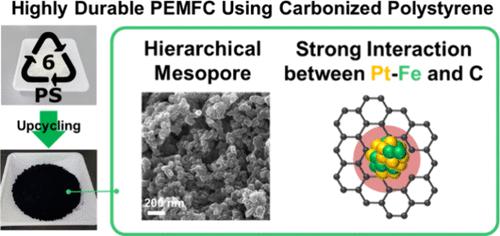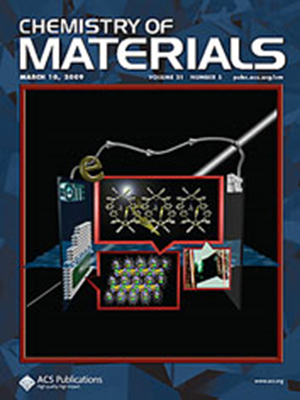Highly Durable Fuel Cells Using Carbon-Bound Platinum Alloy Catalysts Derived from Upcycled Polystyrene
IF 7.2
2区 材料科学
Q2 CHEMISTRY, PHYSICAL
引用次数: 0
Abstract
Developing highly active and durable catalysts with minimal platinum (Pt) usage is crucial for reducing the overall cost of proton exchange membrane fuel cells (PEMFCs). Herein, we introduce a scalable synthesis of carbon-bound catalysts using the upcycling of the polystyrene (PS) polymer. Our approach utilizes solvent-based hyper-cross-linking techniques to spontaneously achieve a hierarchically porous structure in a single-step process. The Pt-loaded PS-derived carbon support features a mesopore structure that enhances mass transport for PEMFCs, despite a low Pt loading of 0.05 mgPt cm–2. The catalyst exhibits excellent durability, retaining 92.1% of its initial power density after 30,000 cycles, owing to its carbon-bound structure and the strong interaction between catalyst and support. In contrast, the power density of commercial Pt/C retains only 35.8% after 30,000 cycles. This approach offers a cost-efficient and sustainable method for upcycling PS polymers into highly durable cathode materials for PEMFCs.

求助全文
约1分钟内获得全文
求助全文
来源期刊

Chemistry of Materials
工程技术-材料科学:综合
CiteScore
14.10
自引率
5.80%
发文量
929
审稿时长
1.5 months
期刊介绍:
The journal Chemistry of Materials focuses on publishing original research at the intersection of materials science and chemistry. The studies published in the journal involve chemistry as a prominent component and explore topics such as the design, synthesis, characterization, processing, understanding, and application of functional or potentially functional materials. The journal covers various areas of interest, including inorganic and organic solid-state chemistry, nanomaterials, biomaterials, thin films and polymers, and composite/hybrid materials. The journal particularly seeks papers that highlight the creation or development of innovative materials with novel optical, electrical, magnetic, catalytic, or mechanical properties. It is essential that manuscripts on these topics have a primary focus on the chemistry of materials and represent a significant advancement compared to prior research. Before external reviews are sought, submitted manuscripts undergo a review process by a minimum of two editors to ensure their appropriateness for the journal and the presence of sufficient evidence of a significant advance that will be of broad interest to the materials chemistry community.
 求助内容:
求助内容: 应助结果提醒方式:
应助结果提醒方式:


